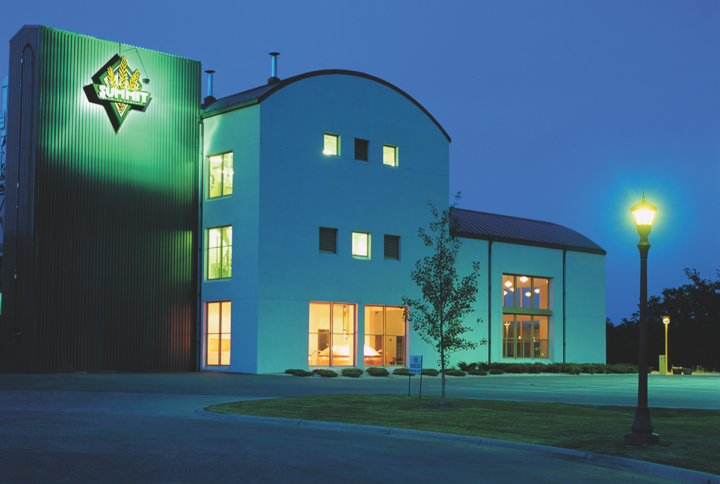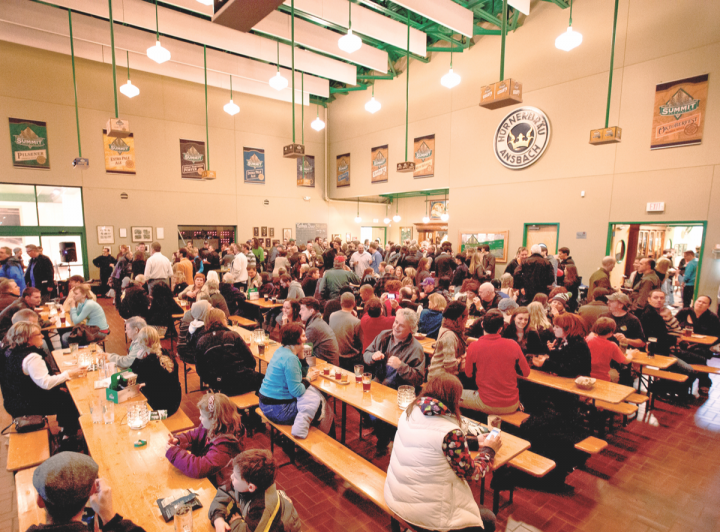
Mark Stutrud is waiting for the dust to settle. The founder and president of St. Paul, Minnesota–based Summit Brewing Co., Stutrud concedes that beer lovers’ current buying habits have put pressure on longtime microbrewers like him. So while those customers continue to sample beer after beer, Stutrud and the Summit Brewing team are focusing on their other customers—their distributors and retail accounts. “We’re making sure we have solid ground on the other two tiers, so that when these drinkers settle down, they’ll realize that we’re consistent, reliable and dependable,” he says.
Summit—the 26th largest craft brewer in the nation by beer sales volume, according to the Brewers Association—has indeed been consistent since its founding 31 years ago. The company produced about 125,000 31-gallon barrels of beer last year, with revenue of $25 million to $30 million, Stutrud says. Amid the increased competition in craft beer, however, Summit’s volume was down about 3 percent in 2016. “It’s become very crowded and confused,” Stutrud says of the craft category. “Beer drinkers today are promiscuous, and brewers and retailers are constantly trying to throw something new at them. That’s not sustainable in the long run.” The confusion and crowding have contributed to a slowdown in craft beer’s velocity, he adds.
Still, Summit remains a stalwart in a space increasingly comprised of upstarts. Stutrud is the largest of a few hundred shareholders in the private company, with the 100 or so employees owning a roughly 30-percent stake. The brewery has 43 distributor partners who generally represent major domestic brewers such as Anheuser-Busch InBev and Miller Coors.

Craft Beer Pioneer
Stutrud, a North Dakota native, founded Summit in 1986, when the first craft beer wave was being established. In opening Summit, he aimed to revive traditional Midwestern brewing methods. The original brewery in St. Paul—which had annual capacity of 3,000 barrels—was housed in a former truck parts company and was the birthplace of the company’s flagship label, Summit Extra pale ale. “I was so preoccupied with survival for the first six to 12 months that I really didn’t think about how big we would become,” Stutrud says of the early days. Nor did he expect that craft brewing would catch on. “I thought that the newer small breweries that survived would be quite regionalized, and that it would be more of a niche business,” he says.
By 1995, Summit was producing 34,000 barrels a year and was setting its sights on building a new brewery at a larger Twin Cities location. The following year, the company purchased four acres of property in a St. Paul business park, and in 1998, brewing commenced at the new site. “It was the first brewery in Minnesota since Repeal that was designed, engineered and built from the ground up,” Stutrud proudly explains. About five years ago, Summit purchased an adjacent property and added nearly 8,000 square feet of cellar space and 12 fermentation vessels, increasing capacity to 240,000 barrels a year. The brewery features a beer hall that’s open for retail sales three days a week and is available to local groups free of charge. “We’ve developed a very strong culture of support for community organizations by using that room,” Stutrud says. In 2014, Summit unveiled its canning facility, packaging its beer in cans for the first time.

Over the years, Summit has expanded distribution from the Twin Cities region to surrounding states, and even in markets as far flung as Texas, New Jersey and Florida. But recently it has been scaling back. Earlier this year, Summit announced that its beers would no longer be available in Pennsylvania, Ohio, Illinois, Indiana, Nebraska and Michigan, leaving only Minnesota, Iowa, Wisconsin, North Dakota and South Dakota. Stutrud explains that the changing craft beer marketplace—there are now nearly 75 craft breweries operating in the Twin Cities metro area alone—and wholesaler consolidation have necessitated the moves. “Distributors have become much wider in terms of territory and much deeper in terms of portfolio,” he says. “It’s essential for a brewer to be functioning at a level with a distributor so that we’re both profitable.” With a much more competitive craft industry, “we decided to take a step back and focus on our core markets,” adds Stutrud, noting that Minnesota accounts for 88 percent of the company’s sales and the five core states represent almost 98 percent of sales. “I’m not going to say that we’re never going to be a national brand, but that’s not our plan for the next few years,” he says. “We have a roughly 3-percent market share in Minnesota and now we can focus on going after a 6-percent market share.”

Competitively Priced Brews
Even after all these years, Summit EPA remains the brewer’s top-selling beer, accounting for half of total production. Five-year-old Sága IPA has emerged as its No.-2 brand and accounts for about 25 percent of the brewery’s volume. “Our pilsner is starting to grow at a slow, but steady rate,” Stutrud says. “We’re getting attention for our lagers, which is atypical in the craft segment.” Among other Summit brews, Stutrud says that its Oktoberfest is one of the best-selling seasonals, and that the eight-year-old Unchained series—three annual releases created by a member of the brewing team—has been well received.
Summit’s beers are competitively priced at $7.99 to $8.99 a six-pack and $11.99 to $13.99 a 12-pack. “The upper Midwest is the cheapest market for beer across the country,” Stutrud says. “We were awfully conservative with pricing when we started in 1986 because there was no other point of reference. We aligned with Canadian imports and were one hell of a value.” In the past few years, Summit has boosted its prices to better support its margins.

Summit’s can packaging (six-packs of 12-ounce cans and 12-packs of 16-ounce cans) has also received a good response, quickly climbing to 17 percent of the brewery’s sales in just three years, according to Stutrud. “Minnesota has an outdoor-oriented lifestyle in every season,” and cans are more convenient for those occasions than bottles, the brewer explains. “A big part of the business that we were missing was in those places where bottles are not appropriate.”
Some 40 percent of Summit’s volume is in draft beer, and the company is thus highly focused on its on-premise sales. But Stutrud notes that the on-premise climate has become increasingly challenged in the Twin Cities due to higher labor costs. Moreover, he notes that Summit, along with other brewers and on-premise operators, faces increasing competition from small craft brewers who can operate on-site taprooms with few restrictions. “It’s been estimated locally that as much as 18 percent of the on-premise business has been pulled away from established bars and restaurants to taprooms,” Stutrud says. In the off-premise, independent retailers comprise Summit’s largest channel, and Stutrud says he’ll continue to “make sure we meet the needs of liquor store operators.”

Eye On Quality
With more than 30 years in the beer business, Stutrud has seen craft beer develop from a niche to a significant, growing segment of the beer market. He’s more concerned with inferior craft beer that he sees entering the market than the widening role of major beer marketers in the craft space. “I have deep respect for the big brands of the world,” he says. “A lot of my colleagues from brewing school work at the big brewers. What they do, they do very well. Unfortunately, I can’t say the same about some of my craft brewing colleagues today.” Stutrud says he’s concerned that too few craft brewers have sufficient labs for quality-assurance purposes and that “sub-standard beer” is reaching the market. For that reason, he encourages retailers to heighten expectations for the beers they receive from craft brewers.
Stutrud vows that Summit will stay independent for years to come, and says that while he and the other owners have discussed strategic partnerships, there’s nothing planned. “There are opportunities, but we’ll be very selective,” he says. Such an arrangement would have to be long-term, he adds, noting that his vision for the company is “that it will outlive me.” And regardless of how the craft segment develops, that vision also includes the continuation of the Summit culture that Stutrud has built over the decades—and the pledge that “everything we do will be of absolute quality.”